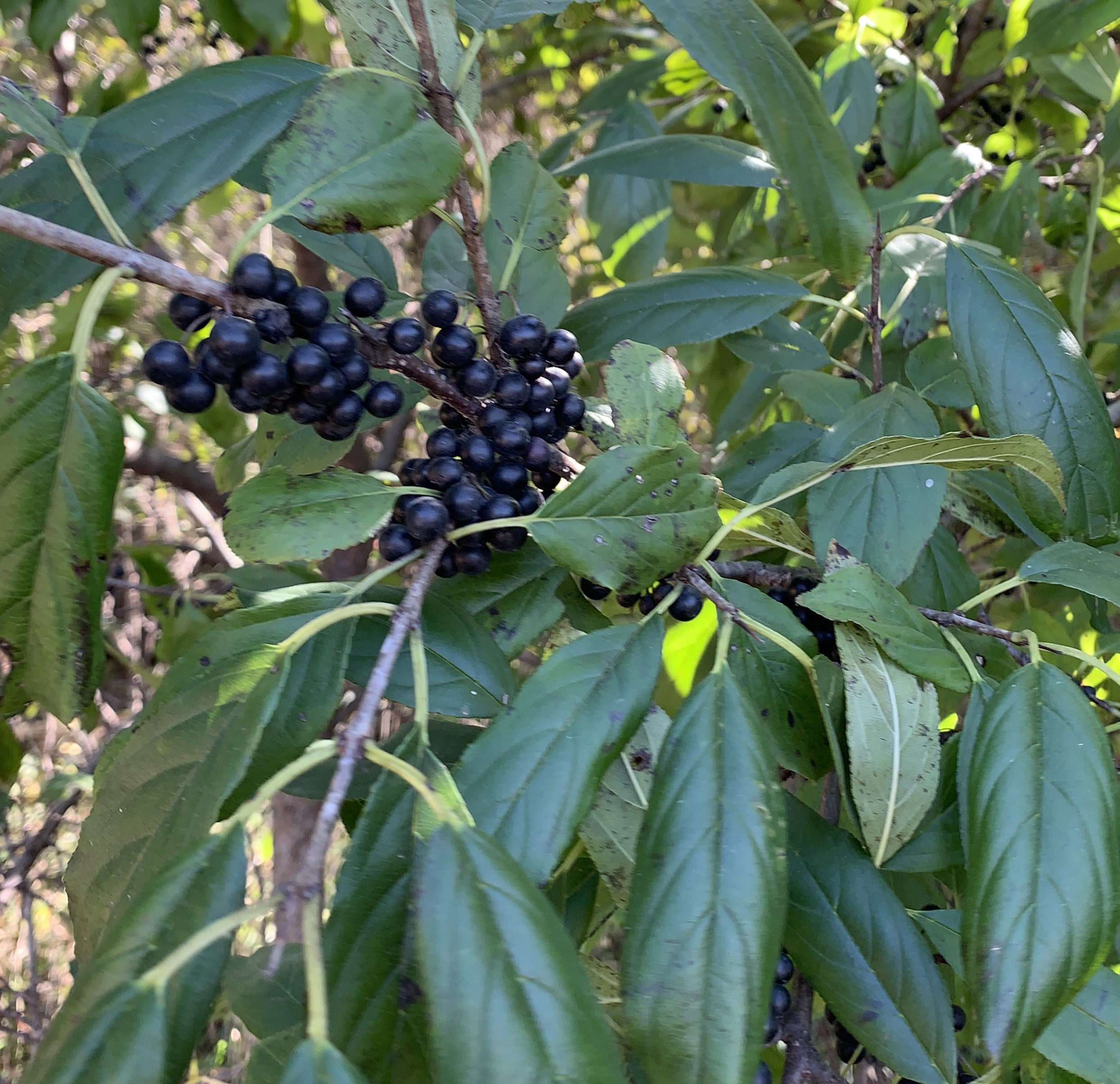Winter food is abundant this fall, with the seeds from foxtails, ragweed, ditchweed, and all the other seeding plants. Berries are ripe, too. Juniper berries, elderberries, pokeberries and more hang in invitation to the birds. And in one spot by the railroad tracks, we found lots of red, white and black berries. The red ones decorated the honeysuckle. The white ones were on the dogwoods, and the black ones hung on the buckthorn trees.
Buckthorn (Rhamnus cathartica), grows like a small tree or a dense shrub, depending on conditions. It is happy in just about any kind of soil, and spreads well in edge areas like Owl Acres, where the ditches, fencerows and woods offer this aggressive plant a foothold. From there, buckthorn is focused on crowding out native species. It can grow to 25 feet, with a spread of about that much. Its leaves are oval and glossy with toothed edges and prominent curved veins. At the ends of the twigs and between the branch and the trunk thorns reach out to snag the unwary and to legitimize the plant’s name. Its bark is rough and brownish-gray. It has yellow sapwood, and the heartwood is pinkish-orange. It’s a deciduous tree, so buckthorn leaves will turn yellow near the end of the fall season before dropping off.
The pea-sized black berries resulted from small, four-petaled greenish-yellow flowers that bloomed in May and June. The berries are red before they ripen, and contain three or four seeds. Birds and small mammals will eat the berries and deposit the seeds far away from the parent tree.
The common buckthorn, also known as the European buckthorn, is native to Europe and northern and western Asia. It was introduced into the United States as early as 1800, and for the next century or more, it both spread naturally and was planted on purpose as an ornamental, as part of a hedgerow, or as a windbreak. As a result, buckthorns are ubiquitous throughout the northern U.S. and southern Canada.
In the 1920s, scientists discovered that buckthorn is an alternate host species for oat crown rust. (Puccinia coronata). This rust is a fungus with a complex lifecycle that requires both oats and buckthorn to complete. Suddenly buckthorn wasn’t such a good idea after all.
Buckthorn also serves as a host plant for Soybean aphids. As part of their own complex lifecycle, the aphids overwinter their eggs on buckthorn.
In England, the brimstone butterfly (Gonepteryx rhamni) uses buckthorn to lay its eggs and feed its caterpillars. The green caterpillars blend in well with the leaves of the buckthorn until they pupate and become large yellow adult butterflies with leaf-shaped wings. The buckthorn is native to England, and so are the butterflies. However, the butterflies didn’t come over with the buckthorn, so our buckthorns don’t host any specific types of caterpillars the way native plants like milkweed host monarchs. Unfortunately, when the buckthorn crowds out native plants, it also impacts the lives of the butterflies and moths that are naturally associated with the native flora.
Buckthorn berries are slightly poisonous and have a strong laxative effect when eaten. This has earned the tree the name “purging buckthorn” in its native England.
Buckthorn is declared to be a noxious weed in Iowa, and a lot of information is available about how to eradicate it. It may be a losing battle, but you can see why everyone seems to want it gone. It crowds out native species; it hosts soybean-destroying aphids; it helps oat crown rust complete its lifecycle. All this bad news doesn’t seem to balance out with the positive—the birds like its berries and the pollinators like its flowers.
Photo by Author. Alt text: Dense cluster of black berries and long, shiny green leaves of Common Buckthorn thrive at the edge of the soybean field. The overwintering birds will eat, and the aphids will live to challenge next season’s beans.
